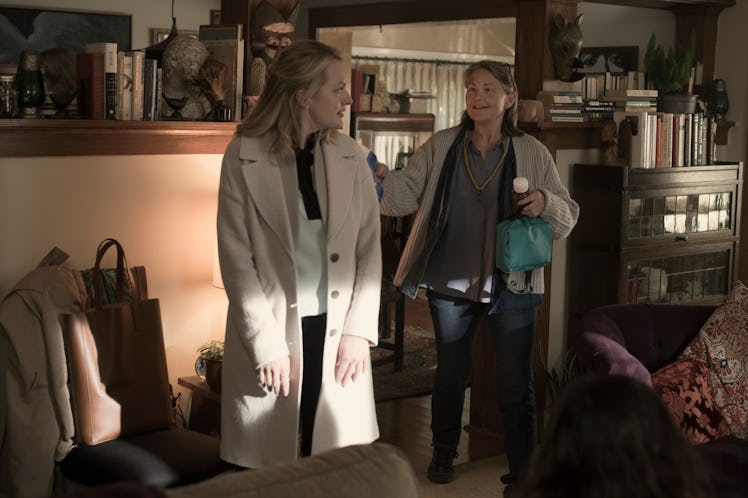
'The Handmaid's Tale' Reveals A New Side Of June's Past & It's So, So Telling
This season, The Handmaid's Tale has pushed to expand its horizons beyond the confines of Offred's little room and the prison of the Waterford mansion. By putting June on Gilead's version of The Underground Railroad to freedom, the series gets to explore new locations as well as new memories which surface as June visits them. One of those leads directly to this season's theme of motherhood, as a pregnant June looks back and remembers her mother. So, who is June’s mother in The Handmaid's Tale, and what's her story? Warning: Spoilers for The Handmaid's Tale Season 2 follow.
One of the more startling images of the June memories so far this season is how feminine her day-to-day outfits were. In Season 1 there weren't many flashbacks and those viewers saw either had June in shorts jogging, in coats because it was cold or on dates wearing jeans. In his memories of June, Luke always seemed to picture her dressed super casually.
But this year, in the memories June flashes back to, she always seems to be dressed for the office in work clothes, and those clothes are always surprisingly feminine, her hair worn down and long, short flirty skirts and very high heels. For instance, the outfit she's wearing the day the attack on Congress goes down shows a ton of skin. It's a heightened contrast to her dowdy outfits in Gilead's present. But it's also a contrast to her mother.
June's mother is an old-school feminist. From as far back as June can remember, she was being taken to feminist events such as Take Back The Night, and her earliest memories are of women throwing the names of their rapists in the fire. June's mother is always trying to convince her daughter to get involved in the feminist movement. Her mother's friends are all hippie types, the kind you can imagine burning their bras in the public square, crying out for equality.
And June is... not that. She's conservative. She's married to a man who divorced his first wife for a her. She's having his kids, she's shaving her legs. She's wearing this very feminine get up because she has to look good for work. Her work is not advancing causes either, but working for a high-end publisher, as it were, for the man. The same man who will lay off every woman in his employ when he needs to in order to keep himself in business. June is not worried about losing her rights, and dismissing he mother's worries about those who are trying.
In a lot of ways, June and her mother's silent fight is representative of the argument going on back when The Handmaid's Tale was first published in 1985. The 1980s were the height of the feminist backlash when Second Wave Feminist Movement (which June's mother represents) ran right into Reagan's America and the deeply anti-feminist movement which put women in sexier clothing and back in the home. These were the women who gave way to the Third Wave Feminists, who tried to own their sexuality in an ironic way while trying to insist any choice they made was feminist, simply because they were female.
One might even say June is a proto Third-Wave-Feminist from her arguments with her mother's friends. She chose to get married, have kids, and to dress pretty, she's just as feminist as they are. But in truth, June admits she just wasn't thinking very hard about it. It didn't register her rights would ever be rolled back until it was too late. It was attitudes like hers that made Gilead possible.
By then, her mother's protests against the state had put her out as part of the first wave sent to the Colonies. The last image June sees of her mother is in a video at the Red Center, dying of radiation poisoning in a propaganda video. But the memory of her mother's legacy stirs June to action. her mother never waited for a man to come rescue her. Now it's June's turn to do the same.